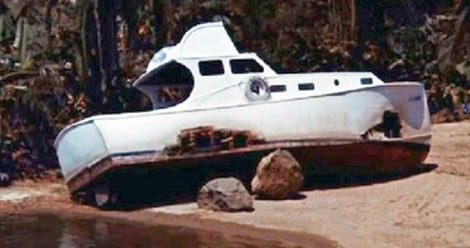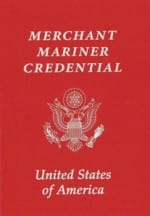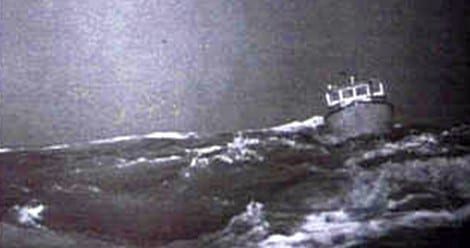 By Bob Currie, Recreational Boating Safety Specialist
By Bob Currie, Recreational Boating Safety Specialist
U. S. Coast Guard Auxiliary Station Galveston Flotilla
Just sit right back and you’ll hear a tale,
A tale of a fateful trip
That started from this tropic port
Aboard this tiny ship.
The mate was a mighty sailing man,
The skipper brave and sure.
Five passengers set sail that day
For a three hour tour, a three hour tour.
The weather started getting rough,
The tiny ship was tossed,
If not for the courage of the fearless crew
The Minnow would be lost, the Minnow would be lost.
The ship set ground on the shore of this uncharted desert isle
With Gilligan
The Skipper too,
A millionaire and his wife,
A movie star
The Professor and Mary Ann,
Here on Gilligan’s Isle.
Source: https://lyricsondemand.com/tvthemes/gilligansislandlyrics.html

Of course, Gilligan’s Isle was a TV show from the 60s, but it can still be used as examples of what could go wrong out on the water. This column will examine the facts around the “shipwreck” of the Minnow and see what could have been done differently in order to have a good outcome where everyone gets home safely.
The Station Galveston Flotilla of the US Coast Guard Auxiliary operates out of the USCG Station Galveston base on Galveston Island. They aid the Coast Guard by providing maritime observation patrols in Galveston Bay; by providing recreational boating vessel safety checks; and by working alongside Coast Guard members in maritime accident investigation, small boat training, providing a safety zone, Aids to Navigation verification, in the galley, on the Coast Guard Drone Team and watch standing.
The Skipper: Captain Jonas Grumby
The Coast Guard refers to the operator of any vessel as the captain, whether they are licensed as such or not. Were he operating a charter boat today, the Skipper most likely would have the lowest level of license, the OUPV Limited Credential, otherwise known as a Six-Pack license. The initials stand for Operator of an Uninspected Passenger Vessel. The license allows the holder of such a license to carry six paying passengers. The Six-Pack license is also known as the Charter Boat Captain’s License. With five paying passengers aboard the Minnow, The Skipper was operating well within the limits of a Six-Pack license; he only had 5 passengers. The credential is called a limited credential because of the six paying passenger limit and because the holder is limited in areas of operation and size of vessel as well. The holder of a Six-Pack license has to undergo a physical, pass a drug test, have certain minimum experience, and pass an extensive exam on Coast Guard regulations, seamanship, navigation, weather, rules of the road, and other maritime topics.
Gilligan
We don’t know much about Gilligan except that he was “brave and sure,” but he was probably a credentialed mariner just as the skipper was. Back in the 60s Gilligan may have obtained a Merchant Mariner’s Document (MMD). The MMD was replaced in 2009 by the Merchant Mariner’s Credential.  An entry-level MMD allowed a mariner to work on the deck as an Ordinary Seaman (OS), in the engine department as a Wiper, or in the steward’s department as a Food Handler (FH). With experience and testing, qualified ratings such as Able Seaman (AB) or Qualified Member of the Engine Department (QMED) can be obtained. The document is about the size of a passport, and contains the sailor’s information regarding date of birth, the location of issue, nationality, and the shipboard duties he or she is qualified for. The document was created shortly after World War II ended in 1945 in order to maintain security in ports around the world when sabotage was still a major concern. Today, the document still serves this purpose, and is regarded as a proof of identity and a passport when a sailor is in a foreign country. So, given that The Skipper and Gilligan were mariners trained and qualified for their respective positions, let’s look at what went wrong.
An entry-level MMD allowed a mariner to work on the deck as an Ordinary Seaman (OS), in the engine department as a Wiper, or in the steward’s department as a Food Handler (FH). With experience and testing, qualified ratings such as Able Seaman (AB) or Qualified Member of the Engine Department (QMED) can be obtained. The document is about the size of a passport, and contains the sailor’s information regarding date of birth, the location of issue, nationality, and the shipboard duties he or she is qualified for. The document was created shortly after World War II ended in 1945 in order to maintain security in ports around the world when sabotage was still a major concern. Today, the document still serves this purpose, and is regarded as a proof of identity and a passport when a sailor is in a foreign country. So, given that The Skipper and Gilligan were mariners trained and qualified for their respective positions, let’s look at what went wrong.
The Weather Started Getting Rough
There is no doubt that the actual cause of the wreck of the Minnow was a typhoon. But how on earth did the boat even end up going out if there was a typhoon nearby? It turns out that the weather service aired the weather forecast for the day before, falsely leading the Skipper to think he was in for a routine cruise. That would do it if all you depended on was a single weather report. Sailors are trained to keep an eye on the weather regardless of any weather report. Although the Skipper was cleared of complicity in the wreck of the Minnow due to the false weather report, and his insurance paid off as well, you can bet there was mention in the Coast Guard investigation that good seamanship demands that sailors use all methods of keeping track of the weather, including visually observing the sky for changes for the worse. In 1972 the IMO (International Maritime Organization) published the International Regulations for Prevention of Collisions at Sea (COLREGS). Rule 5 required that every vessel must designate someone to watch for dangers that may come from any direction. This rule was designed to prevent collisions at sea, but the prudent look-out would also watch for changes in the weather. Although the COLREGS were published after the wreck of the Minnow, it was good seamanship even in the 60s to post a lookout. Today we have immediate access to weather reports on our marine VHF/FM radios. Also, the Coast Guard routinely issues weather bulletins.

The Tiny Ship Was Tossed
A typhoon tends to do that. As the storyline developed over the episodes, we learned that the storm disabled the steering and thus the Skipper could not navigate out of the storm. Without steering they went with the flow and ended up shipwrecked on the island. A boat or ship without rudder control is completely helpless. That is why it is so important to inspect and properly maintain your steering mechanism as well as the other systems of your boat.
Communication Problems
The Minnow was equipped with a shortwave radio that was damaged during the storm. The castaways spent many years on that uncharted island because they couldn’t call for help. The Professor did his best to repair the radio, but he just couldn’t make it work sufficiently to reach help. If the Emergency Position Indicating Beacon (EPIRB) or Personal Locator Beacon (PLB) had been invented back then, and we had communication satellites ringing the globe like we do today, the passengers and crew of the Minnow would have been rescued within days rather than years. The prudent mariner always has a means of emergency communication specific for the voyage. That means that within 20 miles of shore the captain will have a marine VHF/FM radio capable of activating the Coast Guard’s Rescue 21 System. If going out further than 20 miles, in addition to a marine radio you should have either an EPIRB/PLB or a satellite phone in order to make a request for help. Ocean going vessels have more than one radio. The Skipper may have been able to use a backup short wave radio had he thought to furnish the Minnow with one.
Summary
Although the Skipper and Gilligan were absolved of any wrongdoing in the wreck of the SS Minnow, there were some things they could have done differently even 60 years ago that could have saved them from being marooned on a desert island for many years. They could have verified the weather report, they could have visually watched for changes in the weather and headed for a safe port, they could have possibly prevented loss of the rudder by performing routine and periodic maintenance on their steering, and they could have been saved sooner if they had a backup radio. As a mariner you can use the TV show as an example of what you can do to be a better sailor. Even if you don’t seek to be licensed to carry passengers, I recommend that you learn about seamanship, navigation, and all the other skills that a licensed captain must have.
For more information on boating safety, please visit the Official Website of the U.S. Coast Guard’s Boating Safety Division at www.uscgboating.org. Questions about the US Coast Guard Auxiliary or our free Vessel Safety Check program may be directed to me at [email protected]. SAFE BOATING!
[Sep-14-2020]

 Posted in
Posted in 

























Bob:
I thoroughly enjoyed reading and reliving the Gilligan’s Island Minnow story. As a retired U.S. Naval Officer, I understand the value of checking the weather, having back up radios and other necessary communications and just having solid lookouts for the unexpected.
Your analysis was comical but true about what went wrong with the Minnow crew and how things could have been prevented. I enjoyed the trip down memory lane with such a funny but potentially realistic show for any sailor and seagoing vessel.
Thanks
Ron